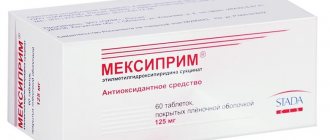Release form and composition
Fentanyl is available in the form of a solution for intravenous and intramuscular administration, which is a colorless transparent liquid (1 ml and 2 ml in ampoules, 5 ampoules in blister packs, in a cardboard pack of 1 or 2 packs, complete with or without an ampoule knife/scarifier it if the ampoules have rings or break points).
Composition of 1 ml solution:
- active ingredient: fentanyl – 50 mcg;
- auxiliary components: citric acid, water for injection.
Composition of the drug
Fentanyl contains only 1 active ingredient - fentanyl. It binds to opiate receptors found in various areas of the nervous system. This leads to a block of noceceptive information. This property allows the drug to be used for the treatment of acute or chronic pain syndrome.
Fentanyl injection is a clear drug that contains 50 mcg of the drug per ml. The solvent is liquid for injection.
Transdermal systems have an adhesive layer for fixation on the skin (polyacrylates), a backing and are protected by a polyethylene layer (siliconized polyethylene terephthalate) from environmental influences. The dosage of analgesic in the patch varies from a minimum of 2.1 mg to a maximum of 16.8 mg.
Pharmacological properties
Pharmacodynamics
Fentanyl is a short-acting opioid analgesic. It activates the analgesic (antinociceptive) system, disrupting the interneuronal transmission of pain impulses and changing the emotional coloring of pain.
In its pharmacological properties, fentanyl is very close to morphine: it inhibits the activity of the respiratory center, increases the pain threshold for various painful stimuli, has a depressant effect on the central nervous system and inhibits conditioned reflexes. Fentanyl differs from morphine in its higher activity (the analgesic effect of fentanyl is 100 times greater than that of morphine), the ability to more strongly depress the respiratory center and the shorter duration of the therapeutic effect.
The analgesic effect of the drug develops quite quickly. With intravenous administration of Fentanyl, the maximum effect develops 1–3 minutes after injection and lasts for 15–20 minutes; when administered intramuscularly – after 3–10 minutes and persists for 1–2 hours.
Pharmacokinetics
For average analgesia, the plasma concentration of the drug should be 15–20 ng/ml. Fentanyl is 79–87% bound to plasma proteins. Its clearance is 400–500 ml/min, its volume of distribution is 60–80 liters, and its half-life is 10–30 minutes. The drug is quickly redistributed from the brain and blood to adipose tissue and muscles.
Metabolism occurs in the liver (by hydroxylation and N-dealkylation), adrenal glands, kidneys and intestines. Fentanyl is excreted by the kidneys in the form of metabolites (75%) and unchanged (10%). About 9% of the drug is excreted as metabolites in bile.
Fentanyl can pass into breast milk.
Analogs
Information about possible analogues of the drug may be useful for patients. These tables contain information about medications that help with pain of varying severity.
| Drug name | Mechanism of action and composition | How to use | Efficiency and price of 1 package |
| Paracetamol | Tablets for oral administration. The active substance is paracetamol. Blocks COX-1, COX-2, providing a central analgesic effect, reducing body temperature | The drug is prescribed to relieve pain from injuries, menstruation, and headaches. The drug is recommended to combat fever in infectious diseases. Allowed for young children and elderly patients. pregnant women. | The drug is effective against pain of mild or moderate severity. The cost of a package of 10 tablets of 500 mg of the drug is from 14 rubles. |
| Ketonal Thermo | A patch with a warming effect. Active component: ketoprofen – inhibitor of COX-1, COX-2. | The patch is prescribed to relieve muscle pain; it is used for discomfort in the back and shoulders. For use only in adult patients. Should not be prescribed to women during pregnancy and breastfeeding. | The drug effectively relieves mild pain and helps relax the muscles of the back or shoulders. The cost of 10 sachets is about 800 rubles. |
| Panoxen | Tablets containing a combination of two non-steroidal anti-inflammatory and painkillers - paracetamol and diclofenac sodium | Recommended for the treatment of pain in various acute and chronic diseases in patients over 18 years of age. The drug is prohibited for the treatment of special categories of people - pregnant and lactating women, patients with severe damage to the heart, liver or kidneys. | The drug has proven its effectiveness against moderate pain syndrome. The cost of a package of 20 tablets is about 138 rubles. |
The drug Fentanyl in ampoules is prescribed during surgical operations in children and adults. It is contraindicated for obstetric interventions and is not recommended for use in persons with brain damage. The instructions for use of the drug warn about the possible development of addiction due to long-term use.
Author: Irina Sizova
Article design: Mila Friedan
Indications for use
- pain syndrome of various origins of medium and severe intensity (myocardial infarction, angina pectoris, pain in cancer patients, postoperative pain);
- pain syndrome caused by spasm of the smooth muscles of internal organs (if the diagnosis is established); Fentanyl is used in combination with antispasmodics and atropine-like drugs;
- premedication before surgical interventions;
- postoperative anesthesia;
- additional pain relief during surgical operations under local anesthesia;
- neuroleptanalgesia (combined intravenous general anesthesia simultaneously with droperidol).
Legal status
Fentanyl and some of its derivatives (carfentanil, remifentanil, sufentanil) are included as narcotic drugs in List II of the List of narcotic drugs, psychotropic substances and their precursors subject to control in the Russian Federation. A number of its derivatives (alpha-menthylfentanyl, alpha-methylthiofentanyl, acetyl-alphamethylfentanyl, acetylfentanyl, beta-hydroxy-3-methylfentanyl, beta-hydroxyfentanyl, 3-methylthiofentanyl, 3-methylfentanyl, para-fluorofentanyl, thiofentanyl) are included in Schedule I of narcotic drugs , the circulation of which is prohibited in the Russian Federation.
Contraindications
Absolute:
- arterial hypotension;
- intracranial hypertension;
- bradyarrhythmia;
- severe hypertension of the pulmonary circulation;
- severe depression of the respiratory center;
- respiratory failure (bronchial asthma, pneumonia, tendency to bronchospasm, collapse of the lung lobe or pulmonary infarction);
- renal and/or liver failure;
- brain tumors;
- extrapyramidal disorders;
- disturbances of consciousness;
- obstetric operations, including cesarean section before the stage of fetal extraction (due to the threat of respiratory depression of the newborn);
- surgical diseases of the abdominal organs in the acute stage (before establishing an accurate diagnosis);
- children under one year of age;
- hypersensitivity to the drug.
Relative (Fentanyl is used with caution):
- renal and/or hepatic colic;
- hypothyroidism;
- urethral strictures;
- prostatic hypertrophy;
- hyperthermia;
- suicidal tendencies;
- history of addiction to opioids;
- traumatic brain injuries;
- simultaneous use of glucocorticosteroids, monoamine oxidase inhibitors, insulin and antihypertensive drugs;
- weakened patients;
- elderly age;
- period of pregnancy and lactation.
During pregnancy and lactation
According to the FDA classification, Fentanyl is classified as Category C. This means that studies on animals during pregnancy have shown negative effects on the fetus.
Similar studies have not been conducted in human populations.
If necessary, the drug can be prescribed to women while pregnant, if the potential benefits of therapy outweigh the possible harm to the fetus. The presence of the active substance in breast milk has been proven. Prescribing Fentanyl requires transferring the child to artificial milk substitutes. Formally, in the instructions for use of the drug, pregnancy and lactation are contraindications to treatment.
Directions for use and dosage
Fentanyl solution is intended for intravenous or intramuscular administration.
For acute pain, the drug is administered in a dose of 25–100 mcg intravenously or intramuscularly (as a single agent or simultaneously with antipsychotics).
For premedication, Fentanyl is administered intramuscularly at a dose of 50–100 mcg 30 minutes before the start of surgery.
For the purpose of induction of anesthesia, the drug is administered intravenously at 100–200 mcg. Then, every 10–30 minutes, an additional 50–150 mcg is administered to maintain the required level of analgesia (in combination with droperidol).
When carrying out neuroleptanalgesia with preservation of spontaneous breathing (for example, during extracavitary and short-term operations), when muscle relaxants are not used, Fentanyl is administered after the antipsychotic at a dose of 50 mcg per 10–20 kg of body weight. In this case, spontaneous breathing should be monitored and readiness for emergency intubation and artificial ventilation should be maintained. Higher doses of Fentanyl (50–100 mcg/kg) are used exclusively during open-heart surgery.
For additional pain relief during operations under local anesthesia, the drug is administered intravenously or intramuscularly at a dose of 25–50 mcg (often in combination with antipsychotics). If necessary, Fentanyl injections are repeated every 20–30 minutes.
For children, the drug is prescribed in the following doses:
- preparation for surgical operations: 2 mcg/kg;
- general surgical anesthesia: 150–250 mcg/kg intramuscularly or 10–150 mcg/kg intravenously;
- maintenance of general surgical anesthesia: 2 mcg/kg intramuscularly or 1–2 mcg/kg intravenously.
Where can I buy
The drug is available in the pharmacy chain only according to established prescriptions, which can be obtained from a doctor at your place of residence or an oncologist by decision of a medical commission. Prescriptions that are not filled on time must be returned to the specialist who wrote them. Unused funds must be disposed of in the prescribed manner.
The estimated cost of packaging the drug is:
- Fentanyl, solution for injection - ampoules of 2 ml, No. 5 - from 80 rubles;
- Fentanyl, transdermal therapeutic system - from 1500 to 3300 rubles per pack of 5 sachets, depending on the dosage of the substance.
Side effects
- digestive system: vomiting, nausea, hepatic colic (in patients with a history of colic), spasm of the sphincter of Oddi, constipation, flatulence;
- respiratory system: laryngospasm, bronchospasm; in large doses – respiratory depression (up to respiratory arrest);
- nervous system and sensory organs: convulsions, headache, increased intracranial pressure, paradoxical excitation or depression of the central nervous system, diplopia, blurred vision;
- other reactions: decreased blood pressure, bradycardia (sometimes to cardiac arrest), short-term muscle rigidity, urinary retention, increased sweating, allergic reactions, tolerance, drug dependence, withdrawal syndrome.
Instructions for use of Fentanyl
According to the instructions for use of Fentanyl, the drug should only be prescribed by healthcare professionals who are knowledgeable about the use of potent opioids for the treatment of chronic pain.
Because of the risk of respiratory depression, fentanyl is prescribed only for use in patients who tolerate such drugs well. When using this drug, it is necessary to reduce the use of other anesthetics to the minimum possible.
Note: Patients are considered opioid resistant if they have previously taken at least 60 mg of Morphine per day, 30 mg of Oxycodone per day, 8 mg of Hydromorphone daily, or other opioids for a week or longer.
It is necessary to prescribe drug dosages for each patient individually, taking into account the previous history of taking analgesics during treatment and the patients’ risk factors for developing drug addiction.
When prescribing any dose of this drug, the practitioner should closely monitor the patient's response, particularly for respiratory depression , especially during the first 24-72 hours after the start of therapy, when serum concentrations from the initial patch reach a maximum.
Dosage
When preparing an adult patient for surgery: IV - 0.05–0.1 mg (in combination with 2.5–5 mg Droperidol) approximately fifteen minutes before the introduction of anesthesia. For surgical anesthesia: IV - 0.05–0.2 mg every half hour.
When preparing children for surgery: 0.002 mg/kg body weight. For surgical anesthesia: IV - 0.01–0.15 mg/kg or IM 0.15–0.25 mg/kg. To maintain surgical anesthesia: IM - 0.001–0.002 mg/kg.
The patch is applied to a flat surface of the skin for 72 hours. In this case, it is very important that the surface of the skin where the patch is applied has minimal hair and does not have obvious manifestations of allergic irritation.
special instructions
Fentanyl TTC should be applied to an intact, non-irritated, non-irradiated, flat area of skin, such as the chest, back, or forearm. For young children and those with cognitive impairment , it is preferable to apply the patch to the upper back to reduce the likelihood of inappropriate patch removal. Hair on the application site must be removed before using the system, and it is not recommended to use a razor for this. The area of skin where the patch will be applied must be cleansed before applying it using warm water without adding detergents.
Fentanyl in the form of TTC must be used immediately after removing the patch from the sealed package. Do not use the drug if its packaging shows signs of damage or depressurization.
Each patch in the package must be changed within 72 hours. To apply the next patch, you must use a new area of skin. If there are problems with edge adhesion, an adhesive plaster can be applied to the patch for fixation.
It is strictly forbidden to: use heat sources, such as heating pads or electric blankets, or point heaters or tanning lamps at the patch site, sunbathe, or take hot baths, hot tubs, or heated water beds.
Overdose
In case of an overdose of Fentanyl, the following symptoms develop: apnea, depression of the respiratory center, bradycardia, decreased respiratory rate, muscle rigidity, decreased blood pressure.
Treatment of overdose consists of stopping the drug and maintaining adequate ventilation. Naloxone (a specific opioid antagonist) is administered intravenously at a dose of 0.4–2 mg; if there is no effect, then after 2-3 minutes the administration of naloxone should be repeated. It is also possible to use nalorphine at a dose of 5-10 mg intravenously or intramuscularly every 15 minutes until a total dose of 40 mg is reached. When administering nalorphine or naloxone to patients addicted to fentanyl or morphine, they may develop withdrawal symptoms; in these cases, the dose of antagonists is increased gradually.
Muscle relaxants are prescribed as supportive and symptomatic therapy, and for bradycardia, a 1% atropine solution in a dose of 0.5–1 ml.
Cost and additional information
The drug can be stored for 24 months from the date of production. After this period, it is undesirable to use it. The TTS must be stored in a dark and dry place where small children cannot reach. The optimal storage temperature is 24-26 degrees Celsius.
Fentanyl patches can be bought today in almost any Russian pharmacy. However, they are sold strictly by prescription because they contain opioids. The price is directly dependent on the size of the records and looks something like this:
- 100 g/h – 4900 rubles;
- 75 g/h – 3800 rubles
- 50 g/h – 3100 rubles;
- 25 g/h – 2200 rubles;
- 12.5 g/h – 1,800 rubles.
The high cost is explained by the effectiveness and quality of the product. As for manufacturers, the most reliable brands are Dolforin, Lunaldin, Fendivia, Durogesic Matrix, Fentadol.
Each of the patches has its own characteristics. Therefore, before using them, you should carefully read the instructions for the fentanyl patch.
special instructions
Fentanyl can only be used in specialized hospital settings. The drug should be administered by highly qualified specialists.
It is necessary to establish careful monitoring of the patient in the postoperative period.
In patients with reduced weight, long-term surgical operations or frequent repeated use of the drug, the duration of its action may increase.
For renal, hepatic and gastric colic, Fentanyl is used simultaneously with antispasmodic and atropine-like drugs, and the patient must be closely monitored.
Impact on the ability to drive vehicles and complex mechanisms
During the period of use of the drug, it is not recommended to perform work associated with increased concentration and speed of psychomotor reactions.
Notes
Notes
- In particular, the famous American singer Prince died from an overdose of illegal fentanyl (“Singer Prince died from an accidental overdose of fentanyl,” RBC, July 2, 2016)
Footnotes
- ↑ 123
“Smack in the suburbs”, BBC_News, 08/31/2016 - Sam Wilson.
Synthetic drug fentanyl causes overdose boom in Estonia. //bbc.co.uk. Retrieved March 30, 2012. Archived May 30, 2012. - ↑ 12
“Nine die in Vancouver in 24 hours from fentanyl opioid overdose,” BBC, 12/18/2016 - American rapper Lil Peep (Russian) has died, RIA Novosti
(20171116T1246+0300Z). Retrieved November 16, 2021. - ↑ 12
“Alleged mass overdose man caught in Connecticut,” BBC, 08/17/2018 - Fentanyl gas was used during the assault
- Two gases were used. During the assault on the Theater Center on Dubrovka, a mixture of fentanyl and halothane was most likely used // “Expert” No. 41 (347) / November 4, 2002
Drug interactions
When Fentanyl is used simultaneously with antihistamines that have a sedative effect and ethanol, the risk of side effects increases.
Benzodiazepines prolong the patient's recovery from neuroleptanalgesia; Beta blockers may reduce the frequency and severity of hypertensive reactions when fentanyl is used in cardiac surgery, but increase the likelihood of bradycardia.
When used simultaneously with monoamine oxidase inhibitors, the risk of severe complications increases; with antihypertensive drugs – the effect of the latter is enhanced.
When used together with muscle relaxants, muscle stiffness is prevented or eliminated; muscle relaxants with vagolytic activity reduce the risk of hypotension and bradycardia, and may increase the risk of hypertension and tachycardia; muscle relaxants that do not have vagolytic activity do not reduce the risk of hypotension and bradycardia, and increase the likelihood of severe adverse reactions from the cardiovascular system.
Fentanyl should be used with caution against the background of the effects of hypnotics, antipsychotics and drugs for general anesthesia, in order to avoid suppression of the activity of the respiratory center and excessive depression of the central nervous system. Dinitrogen oxide increases muscle stiffness, and tricyclic antidepressants increase the likelihood of suppression of the respiratory center.
The drug should not be used in combination with narcotic analgesics from the group of opioid receptor agonists-antagonists (tramadol, nalbuphine and butorphanol) and partial agonists (buprenorphine), since there is a risk of weakening analgesia.
When concomitantly treated with antihypertensive drugs, glucocorticosteroids and insulin, Fentanyl should be used in reduced doses. The analgesic effect and side effects of other opioid agonists (promedol, morphine) in the therapeutic dose range are summarized with the action and effects of fentanyl.
Neuroleptanalgesia
To achieve neuroleptanalgesia, a neuroleptic is first administered, then fentanyl at the rate of 1 ml of 0.005% solution for every 5 kg of the patient’s body weight. The drug is administered slowly - intravenously. For induction of anesthesia, half the dose of fentanyl can be used, followed by the introduction of reduced doses of barbiturates or other anesthetic agents (combined induction).
As a rule, after using an antipsychotic and fentanyl, the patient is administered a muscle relaxant, the trachea is intubated, and auxiliary or artificial ventilation is performed with oxygen or a mixture of oxygen with nitrous oxide or other inhalational anesthetics in reduced concentrations. To maintain analgesia, if necessary, an additional 1-3 ml of 0.005% fentanyl solution is administered every 10-30 minutes.










